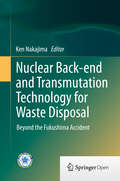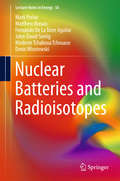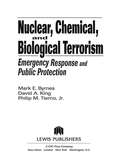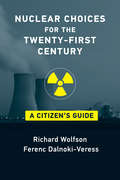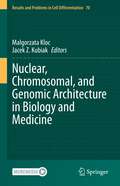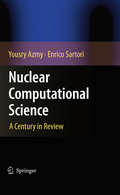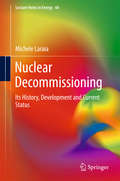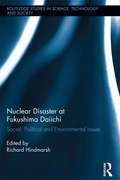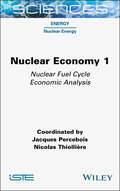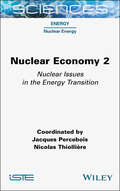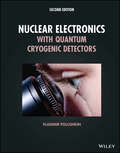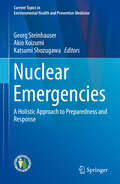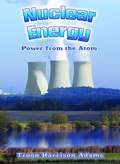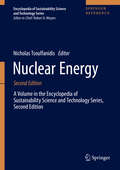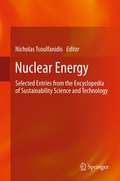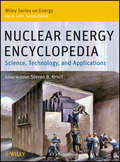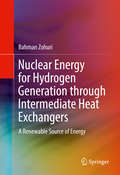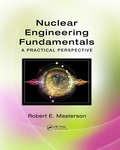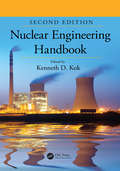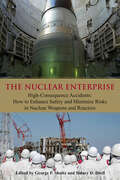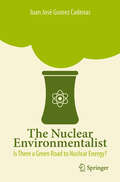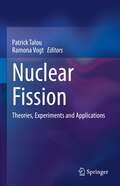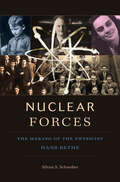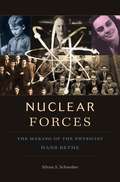- Table View
- List View
Nuclear Back-end and Transmutation Technology for Waste Disposal
by Ken NakajimaThis book covers essential aspects of transmutation technologies, highlighting especially the advances in Japan. The accident at the Fukushima Daiichi Nuclear Power Plant (NPP) has caused us to focus attention on a large amount of spent nuclear fuels stored in NPPs. In addition, public anxiety regarding the treatment and disposal of high-level radioactive wastes that require long-term control is growing. The Japanese policy on the back-end of the nuclear fuel cycle is still unpredictable in the aftermath of the accident. Therefore, research and development for enhancing the safety of various processes involved in nuclear energy production are being actively pursued worldwide. In particular, nuclear transmutation technology has been drawing significant attention after the accident. This publication is timely with the following highlights: 1) Development of accelerator-driven systems (ADSs), which is a brand-new reactor concept for transmutation of highly radioactive wastes; 2) Nuclear reactor systems from the point of view of the nuclear fuel cycle. How to reduce nuclear wastes or how to treat them including the debris from TEPCO's Fukushima nuclear power stations is discussed; and 3) Environmental radioactivity, radioactive waste treatment and geological disposal policy. State-of-the-art technologies for overall back-end issues of the nuclear fuel cycle as well as the technologies of transmutation are presented here. The chapter authors are actively involved in the development of ADSs and transmutation-related technologies. The future of the back-end issues in Japan is very uncertain after the accident at the Fukushima Daiichi NPP and this book provides an opportunity for readers to consider the future direction of those issues.
Nuclear Batteries and Radioisotopes
by Mark Prelas Matthew Boraas Fernando De La Torre Aguilar John-David Seelig Modeste Tchakoua Tchouaso Denis WisniewskiThis book explains the physics of nuclear battery operation. It provides a comprehensive background that allows readers to understand all past and future developments in the field. The supply and cost of radioisotopes for use in applications (focused on nuclear batteries) are covered in the initial sections of the text. The interaction of ionizing radiation with matter is discussed as applied to nuclear batteries. The physics of interfacing the radioisotopes to the transducers which represent the energy conversion mechanism for nuclear batteries are described for possible nuclear battery configurations. Last but not least the efficiencies of nuclear battery configurations are discussed combined with a review of the literature on nuclear battery research.
Nuclear, Chemical, and Biological Terrorism: Emergency Response and Public Protection
by Mark E. Byrnes David A. King Philip M. Tierno Jr.This book provides guidance on measures that should be considered to protect human lives from terrorist activities involving nuclear, chemical, and biological weapons. It provides a historical summary of the development and use of these weapons, and continues with a detailed discussion of the types of radiation and warfare agents that are available
Nuclear Choices for the Twenty-First Century: A Citizen's Guide
by Richard Wolfson Ferenc Dalnoki-VeressAn authoritative and unbiased guide to nuclear technology and the controversies that surround it.Are you for nuclear power or against it? What's the basis of your opinion? Did you know a CT scan gives you some 2 millisieverts of radiation? Do you know how much a millisievert is? Does irradiation make foods safer or less safe? What is the point of a bilateral Russia-US nuclear weapons treaty in a multipolar world? These are nuclear questions that call for nuclear choices, and this book equips citizens to make these choices informed ones. It explains, clearly and accessibly, the basics of nuclear technology and describes the controversies surrounding its use.
Nuclear, Chromosomal, and Genomic Architecture in Biology and Medicine (Results and Problems in Cell Differentiation #70)
by Malgorzata Kloc Jacek Z. KubiakThis volume reviews the latest research on the functional implications of nuclear, chromosomal and genomic organization and architecture on cell and organismal biology, and development and progression of diseases.The architecture of the cell nucleus and non-random arrangement of chromosomes, genes, and the non-membranous nuclear bodies in the three-dimensional (3D) space alters in response to the environmental, mechanical, chemical, and temporal cues. The changes in the nuclear, chromosomal, or genomic compaction and configuration modify the gene expression program and induce or inhibit epigenetic modifications. The intrinsically programmed rearrangements of the nuclear architecture are necessary for cell differentiation, the establishment of cell fate during development and maturation of tissues and organs including the immune, muscle, and nervous systems.The non-programmed changes in the nuclear architecture can lead to fragmentation of the nucleus and instability of the genome and thus cause cancer. Microbial and viral infections can lead to a clustering of centromeres, telomeres and ribosomal DNA and alter the properties of the nuclear membrane, allowing large immobile macromolecules to enter the nucleus. Recent advances in next-generation sequencing technologies combined with nucleus/chromosome conformation capture, super-resolution imaging, chromosomal contact maps methods, integrative modeling, and genetic approaches, are uncovering novel features and importance of nuclear, chromosomal and genomic architecture. This book is an interesting read for cell biologists, researchers studying the structure and function of chromosomes, and anyone else who wants to get an overview of the field of nuclear, chromosomal and genomic architecture.
Nuclear Computational Science
by Yousry Azmy Enrico SartoriNuclear engineering has undergone extensive progress over the years. In the past century, colossal developments have been made and with specific reference to the mathematical theory and computational science underlying this discipline, advances in areas such as high-order discretization methods, Krylov Methods and Iteration Acceleration have steadily grown. Nuclear Computational Science: A Century in Review addresses these topics and many more; topics which hold special ties to the first half of the century, and topics focused around the unique combination of nuclear engineering, computational science and mathematical theory. Comprising eight chapters, Nuclear Computational Science: A Century in Review incorporates a number of carefully selected issues representing a variety of problems, providing the reader with a wealth of information in both a clear and concise manner. The comprehensive nature of the coverage and the stature of the contributing authors combine to make this a unique landmark publication. Targeting the medium to advanced level academic, this book will appeal to researchers and students with an interest in the progression of mathematical theory and its application to nuclear computational science.
Nuclear Decommissioning: Planning, Execution And International Experience (Woodhead Publishing Series In Energy Ser.)
by Michele LaraiaThis book discusses the history of nuclear decommissioning as a science and industry. It explores the early, little-known period when the term “decommissioning” was not used in the nuclear context and the end-of-life operations of a nuclear facility were a low priority. It then describes the subsequent period when decommissioning was recognized as a separate phase of the nuclear lifecycle, before bringing readers up to date with today’s state of the art.The author addresses decommissioning as a mature industry in an era in which large, commercial nuclear reactors and other fuel-cycle installations have been fully dismantled, and their sites returned to other uses. The book also looks at the birth, growth and maturity of decommissioning, focusing on how new issues emerged, how these were gradually addressed, and the lessons learned from them. Further, it examines the technologies and management advances in science and industry that followed these solutions. Nuclear Decommissioning is a point of reference for industry researchers and decommissioning practitioners looking to enrich their knowledge of decommissioning in recent decades as well as the modern industry. The book is also of interest to historians and students who wish to learn more about the history of nuclear decommissioning.
Nuclear Disaster at Fukushima Daiichi: Social, Political and Environmental Issues (Routledge Studies in Science, Technology and Society)
by Richard HindmarshNuclear Disaster at Fukushima Daiichi is a timely and groundbreaking account of the disturbing landscape of the Fukushima Daiichi nuclear meltdown amidst an earthquake and tsunami on Japan’s northeast coastline on March 11, 2011. It provides riveting insights into the social and political landscape of nuclear power development in Japan, which significantly contributed to the disaster; the flawed disaster management options taken; and the political, technical, and social reactions as the accident unfolded. In doing so, it critically reflects on the implications for managing future nuclear disasters, for effective and responsible regulation and good governance of controversial science and technology, or technoscience, and for the future of nuclear power itself, both in Japan and internationally. Informed by a leading cast of international scholars in science, technology and society studies, the book is at the forefront of discussing the Fukushima Daiichi disaster at the intersection of social, environmental and energy security and good governance when such issues dominate global agendas for sustainable futures. Its powerful critique of the risks and hazards of nuclear energy alongside poor disaster management is an important counterbalance to the plans for nuclear build as central to sustainable energy in the face of climate change, increasing extreme weather events and environmental problems, and diminishing fossil fuel, peak oil, and rising electricity costs. Adding significantly to the consideration and debate of these critical issues, the book will interest academics, policy-makers, energy pundits, public interest organizations, citizens and students engaged variously with Fukushima itself, disaster management, political science, environmental/energy policy and risk, public health, sociology, public participation, civil society activism, new media, sustainability, and technology governance.
Nuclear Economy 1: Nuclear Fuel Cycle Economic Analysis
by Jacques Percebois Nicolas ThiollièreThis book presents the factual, precise, complete and accessible economic elements of nuclear energy in order to contribute to an informed and dispassionate debate. It begins with an in-depth analysis of the strategic policies relating to nuclear energy in France and around the world. The methodological aspects are presented exhaustively and illustrated with detailed examples and case studies. This book provides a relevant economic study of the fuel component of nuclear energy. In this context, aspects of the uranium market are presented, before describing in detail the technical and economic components upstream of the nuclear cycle.
Nuclear Economy 2: Nuclear Issues in the Energy Transition
by Jacques Percebois Nicolas ThiollièreThis book presents the factual, precise, complete and accessible economic elements of nuclear energy in order to contribute to an informed and dispassionate debate. It analyzes the economic aspects of spent fuel management, including the costs and financing of long-term storage and deep geological disposal. The economic costs of a nuclear accident are also discussed from both theoretical and applied angles, based on the Fukushima nuclear disaster. Nuclear Economy 2 also examines the industrial and political aspects of the future energy mix. Nuclear energy is thus placed in the more global context of the European electricity market. Finally, this book offers a panorama of energy scenarios on the scale of France, but also of the world.
Nuclear Electronics with Quantum Cryogenic Detectors
by Vladimir PolushkinNUCLEAR ELECTRONICS WITH QUANTUM CRYOGENIC DETECTORS An ideal, comprehensive reference on quantum cryogenic detector instrumentation for the semiconductor and nuclear electronics industries Quantum nuclear electronics is an important scientific and technological field that overviews the development of the most advanced analytical instrumentation. This instrumentation covers a broad range of applications such as astrophysics, fundamental nuclear research facilities, chemical nano-spectroscopy laboratories, remote sensing, security systems, forensic investigations, and more. In the years since the first edition of this popular resource, the discipline has developed from demonstrating the unprecedented energy resolving power of individual devices to building large frame cameras with hundreds of thousands of pixel arrays capable of measuring and processing massive information flow. Building upon its first edition, the second edition of Nuclear Electronics with Quantum Cryogenic Detectors reflects the latest advances by focusing on novel microwave kinetic inductance detection devices (MKIDs), the microwave superconducting quantum interferometers (MSQUIDs) extending by orders of magnitude the scalability of cryogenic detectors implementing newly developed multiplexing techniques and decoding algorithms. More, it reflects on the interaction of quantum cryogenic detectors—which in turn can be paired with semiconductor large frame cameras to provide a broad picture of a sky or chemical sample—and quantum devices, making this second edition of Nuclear Electronics a one-stop reference for the combined technologies. The book also provides an overview of latest developments in front-end electronics, signal processing channels, and cryogenics—all components of quantum spectroscopic systems—and provides guidance on the design and applications of the future quantum cryogenic ultra-high-resolution spectrometers. Nuclear Electronics with Quantum Cryogenic Detectors readers will also find: Fully revised material from the first edition relating to cryogenic requirements Brand new chapters on semiconductor radiation sensors, cooling and magnetic shielding for cryogenic detector systems; front-end readout electronic circuits for quantum cryogenic detectors; energy resolution of quantum cryogenic spectrometers; and applications of spectrometers based on cryogenic detectors A number of brand-new chapters dedicated to applications using MSQUID multiplexing technique, an area that will dominate the cryogenic detector field in the next decades Nuclear Electronics with Quantum Cryogenic Detectors provides a comprehensive overview of the entire discipline for researchers, industrial engineers, and graduate students involved in the development of high-precision nuclear measurements, nuclear analytical instrumentation, and advanced superconductor primary sensors. It is also a helpful resource for electrical and electronic engineers and physicists in the nuclear industry, as well as specialist researchers or professionals working in cryogenics applications like biomagnetism, quantum computing, gravitation measurement, and more.
Nuclear Emergencies: A Holistic Approach to Preparedness and Response (Current Topics in Environmental Health and Preventive Medicine)
by Georg Steinhauser Akio Koizumi Katsumi ShozugawaThis book discusses nuclear events that may become imminent threats to the fabric of our society, and elucidates strategies for preventing these threats or mitigating their adverse effects. It addresses multidisciplinary aspects of various nuclear emergencies, including nuclear accidents, terror attacks involving nuclear materials, illicit trafficking of nuclear materials, and problems related to nuclear forensics and strikes with nuclear weapons/warheads. Very often, nuclear emergencies are only discussed within certain, specific communities. However, this volume brings together experts from various fields to provide a more holistic approach to the problem. Physical, chemical, environmental, social, and medical scientists, together with representatives from the media and authorities, present their views on and strategies for events that cause fear and anxiety among the public – an aspect that can be even more threatening than the direct health effects. The book offers a valuable guide for nuclear scientists, such as radioecologists, health physicists, radioanalytical scientists and nuclear engineers, as well as decision-makers and national/international authorities.
Nuclear Energy: Power From the Atom
by Troon Harrison AdamsBecause of global warming, nuclear energy is getting a second look. This important book discusses the benefits and drawbacks of this controversial, but clean and reliable, source of power. Case studies show how new technologies are helping make production of nuclear energy safer.
Nuclear Energy: Selected Entries From The Encyclopedia Of Sustainability Science And Technology (Encyclopedia Of Sustainability Science And Technology Ser.)
by Nicholas TsoulfanidisThis book provides an authoritative reference on all aspects of the nuclear energy enterprise for both fission and fusion reactors. Featuring 22 peer-reviewed chapters by recognized authorities in the field, the book offers concise yet comprehensive coverage of fundamentals, current areas of research, and goals for the future. Topics range from fundamental reactor physics calculations, reactor design, nuclear fuel resources, and the nuclear fuel cycle, to radiation detection and protection and the economics of nuclear power. All chapters have been updated from the first edition, with new chapters added on small modular reactors, medical applications - atomic and nuclear, and applications of radioisotopes. As each chapter is written by an acknowledged expert in the area, the reader can be assured that the text is accurate, up-to-date, and will appeal to a broad audience of undergraduate and graduate students, researchers, and energy industry experts.
Nuclear Energy
by Nicholas TsoulfanidisNuclear Energy provides an authoritative reference on all aspects of the nuclear industry from fundamental reactor physics calculations to reactor design, nuclear fuel resources, nuclear fuel cycle, radiation detection and protection, and nuclear power economics. Featuring 19 peer-reviewed entries by recognized authorities in the field, this book provides comprehensive, streamlined coverage of fundamentals, current areas of research, and goals for the future. The chapters will appeal to undergraduate and graduate students, researchers, and energy industry experts.
Nuclear Energy Encyclopedia: Science, Technology, and Applications
by Jay H. Lehr Steven B. Krivit Thomas B. KingeryThe A-to-Z reference resource for nuclear energy informationA significant milestone in the history of nuclear technology, "Nuclear Energy Encyclopedia: Science, Technology, and Applications" is a comprehensive and authoritative reference guide written by a committee of the world's leading energy experts. The encyclopedia is packed with cutting-edge information about where nuclear energy science and technology came from, where they are today, and what the future may hold for this vital technology. Filled with figures, graphs, diagrams, formulas, and photographs, which accompany the short, easily digestible entries, the book is an accessible reference work for anyone with an interest in nuclear energy, and includes coverage of safety and environmental issues that are particularly topical in light of the Fukushima Daiichi incident. A definitive work on all aspects of the world's energy supply, the "Nuclear Energy Encyclopedia" brings together decades of knowledge about energy sources and technologies ranging from coal and oil, to biofuels and wind, and ultimately nuclear power.
Nuclear Energy (Energy Essentials)
by Nigel Saunders Steven ChapmanWe can see or feel some types of energy. We can feel the warmth of the summer sun on our skin. Our eyes detect light energy and our ears detect sound energy. But there are some types of energy that we cannot see, hear, or feel. Microwave ovens cook food quickly, using invisible microwave energy. Radios tune in to invisible radio waves and the energy they carry. Nuclear energy is like this. It is invisible and silent, and we cannot feel it. This book describes nuclear energy and what it can do for us.
Nuclear Energy for Hydrogen Generation through Intermediate Heat Exchangers
by Bahman Zohuri· Explains how to use nuclear process heat for industrial applications, especially process heat for hydrogen production · Illuminates the issue of waste heat in nuclear plants, offering a vision for how it can be used in combined-cycle plants · Undertakes the thermal analysis of intermediate heat exchangers throughout the life cycle, from the design perspective through operational and safety assurance stages This book describes recent technological developments in next generation nuclear reactors that have created renewed interest in nuclear process heat for industrial applications. The author's discussion mirrors the industry's emerging focus on combined cycle Next Generation Nuclear Plants' (NGNP) seemingly natural fit in producing electricity and process heat for hydrogen production. To utilize this process heat, engineers must uncover a thermal device that can transfer the thermal energy from the NGNP to the hydrogen plant in the most performance efficient and cost effective way possible. This book is written around that vital quest, and the author describes the usefulness of the Intermediate Heat Exchanger (IHX) as a possible solution. The option to transfer heat and thermal energy via a single-phase forced convection loop where fluid is mechanically pumped between the heat exchangers at the nuclear and hydrogen plants is presented, and challenges associated with this tactic are discussed. As a second option, heat pipes and thermosyphons, with their ability to transport very large quantities of heat over relatively long distance with small temperature losses, are also examined.
Nuclear Engineering Fundamentals: A Practical Perspective
by Robert E. MastersonNUCLEAR ENGINEERING FUNDAMENTALS is the most modern, up-to-date, and reader friendly nuclear engineering textbook on the market today. It provides a thoroughly modern alternative to classical nuclear engineering textbooks that have not been updated over the last 20 years. Printed in full color, it conveys a sense of awe and wonder to anyone interested in the field of nuclear energy. It discusses nuclear reactor design, nuclear fuel cycles, reactor thermal-hydraulics, reactor operation, reactor safety, radiation detection and protection, and the interaction of radiation with matter. It presents an in-depth introduction to the science of nuclear power, nuclear energy production, the nuclear chain reaction, nuclear cross sections, radioactivity, and radiation transport. All major types of reactors are introduced and discussed, and the role of internet tools in their analysis and design is explored. Reactor safety and reactor containment systems are explored as well. To convey the evolution of nuclear science and engineering, historical figures and their contributions to evolution of the nuclear power industry are explored. Numerous examples are provided throughout the text, and are brought to life through life-like portraits, photographs, and colorful illustrations. The text follows a well-structured pedagogical approach, and provides a wide range of student learning features not available in other textbooks including useful equations, numerous worked examples, and lists of key web resources. As a bonus, a complete Solutions Manual and .PDF slides of all figures are available to qualified instructors who adopt the text. More than any other fundamentals book in a generation, it is student-friendly, and truly impressive in its design and its scope. It can be used for a one semester, a two semester, or a three semester course in the fundamentals of nuclear power. It can also serve as a great reference book for practicing nuclear scientists and engineers. To date, it has achieved the highest overall satisfaction of any mainstream nuclear engineering textbook available on the market today.
Nuclear Engineering Handbook (Mechanical and Aerospace Engineering Series)
by Kenneth D. KokBuilding upon the success of the first edition, the Nuclear Engineering Handbook, Second Edition, provides a comprehensive, up-to-date overview of nuclear power engineering. Consisting of chapters written by leading experts, this volume spans a wide range of topics in the areas of nuclear power reactor design and operation, nuclear fuel cycles, and radiation detection. Plant safety issues are addressed, and the economics of nuclear power generation in the 21st century are presented. The Second Edition also includes full coverage of Generation IV reactor designs, and new information on MRS technologies, small modular reactors, and fast reactors.
The Nuclear Enterprise: High-Consequence Accidents: How to Enhance Safety and Minimize Risks in Nuclear Weapons and Reactors
by George P. Shultz Sidney D. DrellA panel of expert contributors offers its views on the risks and rewards of the nuclear enterprise, focusing on issues of safety, regulation, and public perception. Contributors discuss specific experience and issues regarding the technical safety of weapons and power plants, management operations, regulatory measures, and the importance of accurate communication by the media.
The Nuclear Environmentalist
by Juan José Gomez CadenasThis book explains how society will face an energy crisis in the coming decades owing to increasing scarcity of fossil fuels and climate change impacts. It carefully explores this coming crisis and concisely examines all of the major technologies related to energy production (fossil fuels, renewables, and nuclear) and their impacts on our society and environment. The author argues that it is wrong to pit alternatives to fossil fuels against each other and proposes that nuclear energy, although by no means free of problems, can be a viable source of reliable and carbon-free electricity. He concludes by calling for a diversified and rational mix of electricity generation in order to mitigate the effects of the energy crisis. Throughout, the book is spiced with science, history, and anecdotes in a way that ensures rewarding reading without loss of rigor.
Nuclear Fission: Theories, Experiments and Applications
by Patrick Talou Ramona VogtThis book provides advanced students and postdocs, as well as current practitioners of any field of nuclear physics involving fission an understanding of the nuclear fission process. Key topics covered are: fission cross sections, fission fragment yields, neutron and gamma emission from fission and key nuclear technologies and applications where fission plays an important role. It addresses both fundamental aspects of the fission process and fission-based technologies including combining quantitative and microscopic modeling.
Nuclear Forces: The Making of the Physicist Hans Bethe
by Silvan S. Schweber“A highly readable account . . . tracing the future Nobel laureate through his formative years and up to the eve of World War II” (The Wall Street Journal).On the fiftieth anniversary of Hiroshima, Nobel-winning physicist Hans Bethe called on his fellow scientists to stop working on weapons of mass destruction. What drove Bethe, the head of Theoretical Physics at Los Alamos during the Manhattan Project, to renounce the weaponry he had once worked so tirelessly to create? That is one of the questions answered by Nuclear Forces, a riveting biography of Bethe’s early life and development as both a scientist and a man of principle.As Silvan Schweber follows Bethe from his childhood in Germany, to laboratories in Italy and England, and on to Cornell University, he shows how these differing environments were reflected in the kind of physics Bethe produced. Many of the young quantum physicists in the 1930s, including Bethe, had Jewish roots, and Schweber considers how Liberal Judaism in Germany helps explain their remarkable contributions. A portrait emerges of a man whose strategy for staying on top of a deeply hierarchical field was to tackle only those problems he knew he could solve.Bethe’s emotional maturation was shaped by his father and by two women of Jewish background: his overly possessive mother and his wife, who would later serve as an ethical touchstone during the turbulent years he spent designing nuclear bombs. Situating Bethe in the context of the various communities where he worked, Schweber provides a full picture of prewar developments in physics that changed the modern world, and of a scientist shaped by the unprecedented moral dilemmas those developments in turn created.Praise for Nuclear Forces“Schweber’s account of Hans Bethe’s life . . . reveals the origins of a charismatic scientist, grounded in the importance of his parents and his Jewish roots . . . [Schweber] recreates the social world that shaped the character of the last of the memorable young scientists who established the field of quantum mechanics.” —Publishers Weekly“Nuclear Forces is a carefully researched, historically and biographically insightful account of the development of a profession and of one of its leading representatives during a century in which physics and physicists played key roles in scientific, cultural, political, and military developments.” —David C. Cassidy, author of A Short History of Physics in the American Century
Nuclear Forces: The Making of the Physicist Hans Bethe
by Silvan S. SchweberOn the fiftieth anniversary of Hiroshima, Nobel-winning physicist Hans Bethe called on his fellow scientists to stop working on weapons of mass destruction. What drove Bethe, the head of Theoretical Physics at Los Alamos during the Manhattan Project, to renounce the weaponry he had once worked so tirelessly to create? That is one of the questions answered by Nuclear Forces, a riveting biography of Bethe’s early life and development as both a scientist and a man of principle. As Silvan Schweber follows Bethe from his childhood in Germany, to laboratories in Italy and England, and on to Cornell University, he shows how these differing environments were reflected in the kind of physics Bethe produced. Many of the young quantum physicists in the 1930s, including Bethe, had Jewish roots, and Schweber considers how Liberal Judaism in Germany helps explain their remarkable contributions. A portrait emerges of a man whose strategy for staying on top of a deeply hierarchical field was to tackle only those problems he knew he could solve. Bethe’s emotional maturation was shaped by his father and by two women of Jewish background: his overly possessive mother and his wife, who would later serve as an ethical touchstone during the turbulent years he spent designing nuclear bombs. Situating Bethe in the context of the various communities where he worked, Schweber provides a full picture of prewar developments in physics that changed the modern world, and of a scientist shaped by the unprecedented moral dilemmas those developments in turn created.
